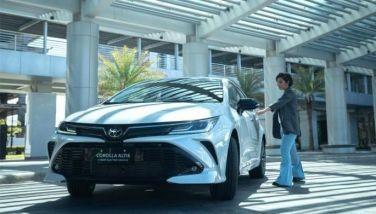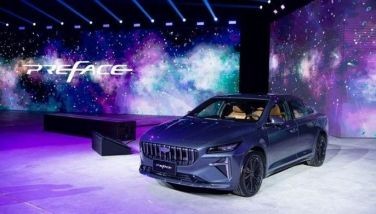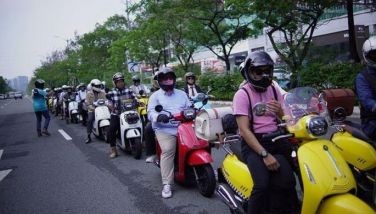Knowing the cause of traffic jams is not enough?
It doesn’t need a genius like Einstein to know that the basic reason why we have traffic flow problems in the metropolis is because we have too many vehicles for the size and number of roads we have.
Having said that, to solve the problem is to either widen or increase the number of roads we have in Metro Manila or reduce the number of vehicles that make use of the roads.
Again it won’t take a rocket scientist to figure out that widening or increasing the present number of roads is less feasible or practical than just reducing the number of vehicles.
If you don’t agree with that simple logic it won’t make me feel bad if you opt to choose another article to spend your time reading, while if you do agree, please read on.
The kinds of vehicles that ply the metro roads can be classified into three main groups, namely; for private use, for public conveyance (PUVs) and for commercial or business use. Sharing the same previously cited logic, the traffic managers of the metro started conceiving ideas to reduce their numbers as a most practical way to solve the traffic problem.
Those that use private vehicles for transport were the first ones targeted with a “vehicle reduction scheme†or “number coding,†where certain number-endings of registration plates were banned to travel on specific days and hours.
Up to now many are still questioning the constitutionality of the measure as it runs counter to one’s right to own and use private property. But then, why not, if it really can reduce the number of vehicles on the road and thus help lessen traffic problems.
How effective is the solution is still in question though because as it turned out, many just opted to buy a second vehicle in order to live normal lives instead of looking for alternative modes of transport on days that their sole vehicle is not allowed to be used. Of course this added more vehicles to contend with, which defeats the purpose for which the measure was thought of in the first place—to reduce the number of vehicles.
We go now to the PUVs or public utility vehicles that ply our streets. Even the blind can discern that there are just too many of them, judging merely by the noise and air pollution that they cause. Buses especially, run half empty most of the day, proof that there are more of the buses than the commuters that still want to make use of them (as many are now opting for the safer, cleaner and more reliable mass rail transport system). Worse, a closer scrutiny of these buses would reveal that a good number of them are illegally plying, either illegally out of their assigned routes or are just plain illegally running. They are colorums or vehicles without proper franchises; some are even not properly registered. Perhaps an “all out, no nonsense campaign†to rid our streets of these colorums (even just along EDSA to begin with) would dramatically reduce the number of vehicles gunning for the same little real estate left exclusively for vehicles. It appears that there is a dire need for a stricter legislation with harsher punishments for violators in order to effectively rid our streets of colorums.
The other kind of PUV, which is less in number but has more or less the same amount of impact to the ever-growing traffic problem in the metropolis (if only for their humongous size), are the provincial buses. Their classification alone should put them where they belong—outside of the metro. The provincial buses have no business passing through the streets of Metro Manila. Their terminals as well have no place in the metro. Have you had the chance to observe how these huge provincial buses take all the space and the time to maneuver in and out of their terminals, many of them located in the heart of some cities of the metro, like Manila, Pasay and Quezon City, causing all that traffic and inconvenience to other motorists, commuters and pedestrians? The government should be hell-bent on putting up huge common bus terminals—one in the southern tip of the metro and the other in the north and banning the operation of bus terminals within the Metro Manila area.
The third group of vehicles that makes use of our roads is composed of those that are for business, like delivery vans, hauling and container trucks and the like. I cannot agree more to the fact that these vehicles are major tools that help hasten the turning of the wheels of the country’s trade and commerce contributing to a healthier economy. It is this resolute belief that convinces me that these types of vehicles should be given a more convenient and economically viable time of the day to conduct their business—at night and not during the day where they have to content with the horrendous traffic of other vehicles and pedestrians. It is only during the night that they would be able to make more delivery trips compared to doing it during the day. It is only during the night that they don’t have to consume too much fuel while running bumper to bumper, stop and go. It’s only during the night when drivers can make their deliveries with comfort enjoying the cool night breeze instead of spending hours inside their hot delivery vans. Commercial deliveries in many countries are done during the night and have been proven to be more economically viable both to haulers and business establishments. It’s only a matter of adjusting schedules without the need of hiring extra hands. This concept should be given more serious consideration and study. It’s proven to be effective in other countries and I don’t see why it won’t be here.
As you may now realize, we know the basic reason why we have traffic flow problems in the metropolis. As a matter of fact, we actually even know how to go about improving the traffic flow. But do we have the political will to do what should be done?
The long wait is over
Since Toyota Motor Philippines Corporation (TMPC) started coming out with print teaser ads about the coming of the All New Toyota Vios, many subcompact sedan enthusiasts have been holding their breath eager to finally see the much-awaited model in the flesh.
And it was in grand fashion, as usual that TMPC presented to the public the vehicle whose name, Vios means “to move forward,†complete with a wide array of performing bands, talents and fun activities last Friday, July 12 at the NBC Tent at the Bonifacio Global City.
What’s new in the All New Vios?
“Waku Doki†or Fun to Drive Vehicles is Toyota’s thrust where the All New Vios is vaunted to be based on with new features like a redesigned exterior composed of new headlamps, an aggressive-looking grille and newly-designed tail lamps. It also has a slightly bigger cabin than its predecessor with the aim of making it more comfortable for its passengers.
“Not to fix what ain’t broke,†the All-New Vios comes with the same reliable VVT-I engine, 4-cylinder in-line DOHC 16 valve engine with electric fuel injection (EFI).
Six variants are available that start with a low P592,000.00 for a 1.3 Base model and a high of P847,000.00 for a 1.5 with automatic transmission (AT).
The Vios Launch Party was a huge riotous success and the fans came in hordes.
Hats off to TMPC!
A new Ford Fiesta in the market
“Our aim with the new Ford Fiesta was to take a popular car that was already a segment leader in fuel efficiency, performance and personality and make it even better. Ford Fiesta continues to push the boundaries and seal its credentials as the small car that stands out from the competition,†was the confident statement of the newly designated managing director of Ford Philippines during the launch of the new Ford Fiesta last week.
Well, the past remarkable sales performance of the Fiesta in the country and the upgrades that it now offers undoubtedly merit such confidence from the new lady at the helm of this iconic American brand that’s presently doing well despite its surprise decision to cease operations of its manufacturing facilities in the country.
Aside from the new Fiesta’s upgrades in its technologies with several new features including the hands-free in-car connectivity system Ford SYNC and two powertrain options, the array of variants to fit particular budgets and specific likes and tastes can bring the enthusiasts to their showrooms for a serious look-see and possible purchase.
Though I failed to make it to the launch, I was told it was well-attended and a big success. Congratulations to Ford Philippines.
A taste of the BMW lifestyle
Asian Carmakers Corporation (ACC), exclusive importers of premium brand BMW vehicles promised a far from the usual test drive activity for the BMW X1 that was held last week.
Most of the invited motoring journalists were intrigued, especially when each was lent a different kind of cellphone a few days before the actual event with specific instructions to do things like take pictures of one’s self, the food that we take, the exercise that we perform, even the clothes that we wear, etc., using the lent phone.
Aside from not understanding what’s all that pre-test drive activities were all about, being no techie and with all the intentions of not becoming one at this age, I begged off from doing any of them and just committed to my good friend Glen Dasig, executive director of ACC to just do what most dyed-in-wool motoring journalists like to do and that’s to test drive.
Well, after consuming a delectable and sizeable angus tapa (was it?) for breakfast and listening to a technical presentation on the statistics regarding people who are now very much into the use of smartphones and to what economic strata they belong (the market of Premium Brand BMW vehicles), did I begin to understand what’s up ahead for the day, which the lovely president of ACC, Maricar Parco promised to be a leisure day ahead and a taste of the BMW lifestyle.
No I don’t wish to make my dear readers salivate with the kind of day we lucky motoring journalists had with the ACC-BMW gang, but we had a nice and memorable experience—“a day in the life of a BMW owner or future buyerâ€. And that’s not counting the hands-on experience we had with the BMW X1, which if I remember how lovely Maricar describes it during its recent launch, “The first compact luxury Sports Activity Vehicle in the premium car market.â€
By the way, the BMW X1 is currently leading in the combined online votes and unit sales in the Luxury subcompact category in the on going Auto Focus People’s Choice Awards public voting, the yearly polls that determine the most preferred vehicles in each category and the most popular automobile in the country for 2013-2014.
You can log on to our website www.autofocus.com.ph or “like†us on our Face Book page to vote or to get updated on the current standings.
Be involved, file your report
Check out our Motoring Today Facebook page to report motoring problems in the metro as well as sightings of wanton disregard for traffic rules and regulations. Send photos or videos showing location of the problem and plate numbers of the violators.
You report it, and we refer it to the government agency involved for the appropriate action.
Happy Motoring and Happy Anniversary to the Philippine Star!!!
For comments email [email protected].
- Latest






























